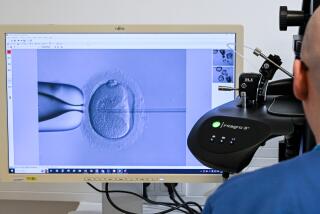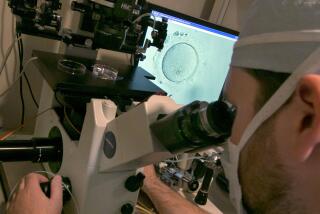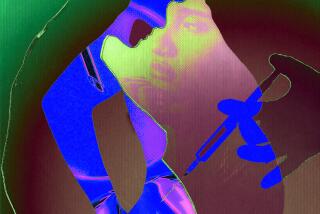‘Whenever possible, we all go over and hold the baby and get our picture taken.’
- Share via
Cyndy Osborn says her job makes great party talk--she is a part of a team that makes “test-tube babies” at Childrens Hospital and Health Center. A 35-year-old acting supervisor of the Genetic Laboratory who started her career as a volunteer there five years ago, Osborn feels fortunate to be working in a new field that is both scientific and emotionally charged. She and her husband left rural Illinois to see the country in a van 14 years ago. They landed in San Diego when cold-weather camping and the end of the Washington apple-picking season drove them south. Osborn found her niche in the study of genetics at San Diego State University, where she earned a bachelor of science degree. She now lives in Clairemont with her husband and 5-year-old son and awes relatives back home with talk of the in vitro fertilization program. Times staff writer Nancy Reed interviewed her at the hospital, and David Gatley photographed her there.
The first time you actually look in the microscope and see that the fertilized egg really has divided and become an embryo, I don’t think I will ever forget that. I will never forget the electricity in the room. It is a very small, very little, sterile room.
Some of it was, “We did it!” But we also . . . revered what we did.
It is very, very, exciting that you might be creating life--you realize that--and that you are actually fertilizing an egg. At first, you just spend the whole day thinking about it. But mostly you are thinking, I don’t want to mess it up. Everybody has gone through so much--the patient, the husband, the doctors, the nurses--everyone in the program has done their part, and I want to do my part exactly right.
The first time our program ever got a pregnancy, it was wonderful, we were all ecstatic. It’s stressful. The ups and downs, so many things could go wrong, and sometimes they do, and you have to deal with that.
Usually you don’t know why they didn’t fertilize, and I guess that is what is so frustrating--we don’t know all the answers.
The main group of women that go into the program have had damage to their Fallopian tubes. The woman is put on drugs to superovulate--to develop lots of eggs. We monitor those through ultrasound and levels in their blood. We know that they are cycling--timing is very critical.
Hormone injection causes them to ovulate, and we have 36 hours to get to the operating room and surgically remove the eggs before they ovulate. That is the first stage.
We have an Isolette set up in a corner of the operating room--we have dishes, tubes and a microscope. We take fluid, put into it into the dish and look at it microscopically to see if there is an egg in it. We are kind of egg spotters.
If there are (eggs), we hurry back to the laboratory and put them in their little dishes. Anywhere from three to 10 eggs.
The organ culture dish has a little well and a moat around it. When we introduce sperm into egg we mostly think, “Good luck.” We all have our fingers crossed, and we all kind of give it our little blessing in our own way.
The next morning you go in and see if you have gotten fertilization. By the next day it should be a two-cell or a four-cell embryo--it is not an egg and a sperm anymore, it is an embryo.
You go through all this . . . you give it back to the lady and hope it implants--or all of it is wasted.
Then we wait.
We haven’t gotten to see all of our babies that have been born, but whenever possible, we all go over and hold the baby and get our picture taken. . . . That’s the fun part and the parents are just so, so happy.
And a lot of them still write to us and keep us informed of what is going on.
The oldest we have is only a year old--we are a real new program. I think we have six that have been born and three that are still in progress.
I have a fantasy about some day, maybe by chance, I will run across one of these babies. Because you might remember the name. Maybe my kid comes home and says, “So and so in my class . . . “ and I’ll say, “Who?”






